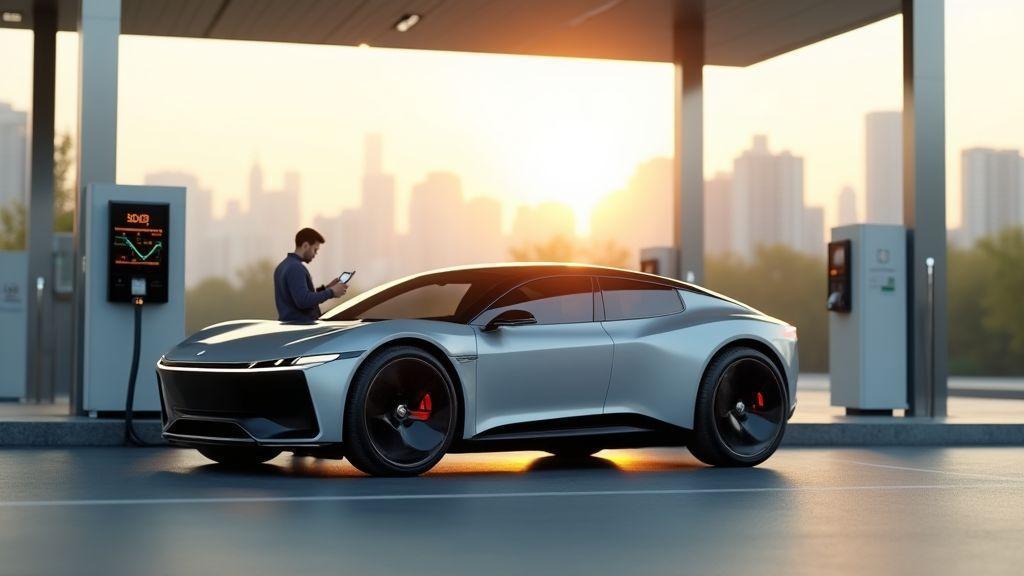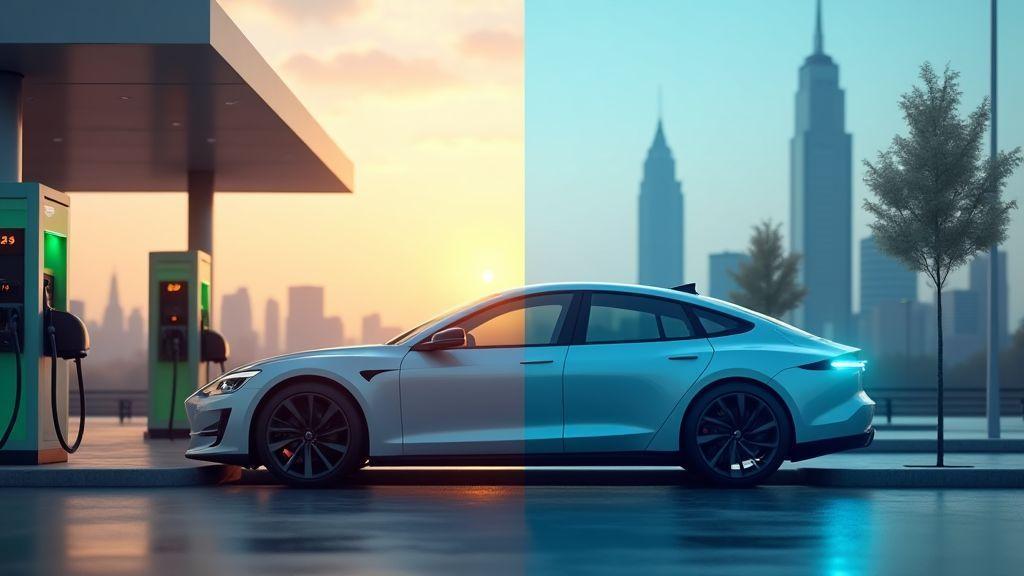Hybrid vs Electric Cars: Which Is the Better Choice in 2025?
You get clear, practical guidance on fuel savings, charging versus pumping, total cost of ownership, range and charging options, environmental impact, incentives, and maintenance. Short, easy steps show how to compare upfront price, yearly fuel and electricity costs, and resale value so you can plan payback time. Use this guide to pick the car that fits your driving habits and your budget. For calculators, model comparisons, and related guides, visit our site homepage.
Key Takeaway
- You save on fuel with hybrids, but electric cars cut fuel costs more.
- You may pay more up front for electric, but running costs are lower.
- Choose electric if you have reliable charging at home or work.
- Keep driving farther with hybrids when public charging is scarce.
- Many electric cars qualify for tax credits or rebates.

How your daily fuel use favors hybrids in 2025
Hybrids still shine if your day-to-day driving blends short trips and occasional highway runs. In town with frequent stops, a hybrid’s electric assist and regenerative braking cuts gas use every time you slow down, saving money without changing your routine.
You also get predictable range without the hassle of public chargers. On long trips a hybrid switches to gasoline and keeps going, making hybrids a safe bet if you want lower weekly fuel bills but also long-range freedom for weekends or work trips.
Fuel prices and charger access vary by neighborhood. In 2025 many places raised public fast-charge fees while home electricity stayed relatively steady. If you don’t have fast chargers nearby or value simple refueling, a hybrid often gives better real-world savings for mixed driving than a pure EV.
Hybrid car fuel efficiency 2025: what you should expect
Modern non-plug-in hybrids commonly deliver roughly 40–55 MPG combined. That depends on how much city driving you do, how heavy your foot is, and whether the system is tuned for efficiency or sport. Expect the best gains in stop-and-go traffic.
Plug-in hybrids show two figures: electric range (often 20–50 miles) and gasoline MPG when the battery is depleted. Short daily commutes can be mostly electric; longer drives switch to efficient gas use.
| Type | Typical EPA figure (2025) | What that means for you |
|---|---|---|
| Standard Hybrid | 40–55 MPG combined | Low fuel use in city/highway mix; no plugging needed |
| Plug-in Hybrid (PHEV) | 20–50 mi electric range 30–45 MPG gas | Short commutes use electricity; long trips use gas backup |
| Battery EV (for context) | 100–130 MPGe | Lowest operating cost per mile but needs charging access |
How you save at the pump versus charging at home
If you charge at home, an EV’s cost per mile is often lower than gasoline, but setup and location matter. Count charger install cost, electricity rates, and how often you drive beyond a single charge. Renters or those without off-street parking may struggle with home charging, reducing the EV’s cost edge. Hybrids cut gas use without relying on home charging. See government guidance on EV charging at home and publicly for installation considerations and cost factors.
To estimate savings:
- Track your weekly miles and fuel used for two weeks.
- Multiply EV electricity cost (kWh price × kWh per mile) or gas cost per mile (price per gallon ÷ MPG).
- Add monthly charging or convenience costs (home charger payment, public fast-charge fees) and compare.
A PHEV can be the sweet spot if your daily run is under its electric range. A standard hybrid wins if you want steady fuel savings without charging.
Common EPA fuel economy figures and what they mean for you
EPA labels give city, highway, combined MPG for hybrids and MPGe plus electric range for EVs and PHEVs; treat them as a starting point. Use the combined number to compare models, but expect real-world MPG to vary with speed, climate, and cargo. For short commutes, electric range and MPGe tell you how often you’ll avoid the pump. For longer drives, combined MPG shows real gas cost.
How to compare total cost of ownership EV vs hybrid 2025
Start with real numbers: purchase price, tax credits or dealer rebates, and annual costs for energy, maintenance, and insurance. Plug those into a 5- or 10-year worksheet. Compare vehicles and ownership costs using official EPA ratings, MPGe, and the calculators provided to estimate fuel/electricity costs and ownership totals.
Think about how you drive. Lots of short trips and home charging usually favor EVs for lower yearly energy and service visits. Long highway runs or unreliable charging favor hybrids for time and range. Use your actual miles per year as the anchor for estimates — the rest follows.
Don’t forget resale and battery guarantees. Battery warranties and residuals can swing long-term costs. A small shift in resale price can flip the winner, so treat that line as important, not optional.
| Item | Typical EV (2025 example) | Typical Hybrid (2025 example) |
|---|---|---|
| Sticker price | $40,000 | $30,000 |
| Incentives/rebates | -$7,500 | $0 |
| Net upfront cost | $32,500 | $30,000 |
| Energy per year | $600 | $1,600 |
| Maintenance per year | $400 | $700 |
| Insurance per year | $1,200 | $1,000 |
| 5-year total cost | $43,500 | $46,500 |
How you weigh upfront price, incentives, and rebates
Start by subtracting every government or dealer credit from the sticker price for the net cost. Add home charging installation cost for EVs so you compare apples to apples. Treat incentives as one-time savings. Also compare financing terms; a lower APR on an EV loan can matter as much as a rebate.
Checklist:
- List sticker price and dealer fees for each model.
- Subtract federal, state, and local incentives.
- Add one-time costs (home charger, adapter, extra tax).
- Compare net financed amount and APR.
How you estimate yearly fuel, electricity, and insurance costs
Convert driving to cost per mile. Use average MPG for hybrids and kWh per 100 miles for EVs, then apply local fuel and electricity rates. Multiply by yearly miles for annual energy cost.
Insurance often surprises: EVs can cost more because of repair costs; hybrids can be cheaper. Get quotes for specific models and use those numbers for yearly totals.
Calculate payback time using simple yearly totals
Add annual differences in energy, maintenance, and insurance, then divide the extra upfront cost by that yearly saving to find payback years. If the EV net cost is $2,500 higher and you save $800 a year, payback is ~3.1 years.

What electric vehicle range improvements 2025 mean for your trips
Range gains in 2025 change how you plan drives: many mainstream EVs now reach 250–400 miles per charge in real-world use, cutting charging stops on long trips. Some road trips now require fewer stops and less planning than a few years ago.
For short daily drives, if your commute is under 50 miles you can go days between charges. Weekend trips become easier too. Weather, speed, and towing still reduce range, but longer ranges let you skip crowded chargers and enjoy more spontaneity. To estimate charging costs you should understand residential electricity pricing and rates, since local rate structures affect cost per mile.
What range numbers you can expect and how they affect you
Expect real-world ranges:
- Entry EVs: 180–260 miles
- Mid-range EVs: 250–350 miles
- Long-range models: 350–500 miles
- PHEVs: 20–60 miles electric-only
If your daily round trip is 60 miles, a 300-mile EV will go several days without charging; a 200-mile EV will need top-ups more often. PHEVs free you from range anxiety on long trips but only save time if you charge regularly.
| Vehicle type | Typical electric range (miles) | Charges needed on a 300-mile trip |
|---|---|---|
| Long-range EV | 350–500 | 0–1 stops |
| Mid-range EV | 250–350 | 0–1 stops |
| Short-range EV | 180–250 | 1 stop |
| Plug-in hybrid (electric only) | 20–60 | Uses gas after electric range |
| Regular hybrid (gas electric assist) | N/A | No EV stops required |
Charging infrastructure availability 2025: where you can charge on trips
Fast chargers are common on highways, near big towns, and at travel plazas. City streets and apartment complexes lag, but workplace and parking garage Level 2 chargers are growing. Rural roads still have fewer fast chargers. Hotels, restaurants, and parks are adding chargers, so you can plan stops around meals and breaks.
Plan trips with public charger maps and apps
Use apps like PlugShare, ChargePoint, and A Better Routeplanner to find charger type, power, live status, and photos. Filter by speed and availability, save favorites, and check prices and membership rules before you arrive. If you need personalized assistance comparing local charger options or incentives, reach out through our contact page.
How your choice changes emissions: environmental impact EV vs hybrid 2025
Choosing an EV eliminates tailpipe emissions immediately, but doesn’t erase emissions from battery manufacturing or electricity generation. Hybrids lower fuel burned on trips but still produce tailpipe emissions when the gas engine runs. Hybrids usually have lower manufacturing emissions than large EV batteries but not the full zero-tailpipe benefit.
Which wins in 2025? Hybrid vs Electric Cars: Which Is the Better Choice in 2025? depends on how the car is made, where you charge it, and how you drive. Short errands in a hybrid can beat an EV charged from a coal-heavy grid; long daily commutes charged with clean power usually favor an EV.
| Vehicle type | Tailpipe emissions | Manufacturing emissions | Typical lifecycle outcome |
|---|---|---|---|
| Battery EV | Zero | Higher (battery production) | Often lower lifecycle emissions on clean grids |
| Hybrid | Low to moderate | Moderate | Middle ground; better than ICE in most cases |
| Gasoline ICE | High | Moderate | Highest lifecycle emissions overall |
Tailpipe emissions versus full lifecycle emissions you should know
Tailpipe emissions are immediate and visible. In city driving an EV cuts local pollutants right away. Full lifecycle emissions include mining, manufacturing, shipping, fuel/electricity generation, and recycling. Many studies show EVs start with higher manufacturing emissions but pay that back in lower operational emissions—especially on cleaner grids. Hybrids start with lower manufacturing emissions but continue burning fuel. For authoritative guidance, see EPA resources to compare vehicle lifecycle greenhouse emissions and how grid mix affects total emissions.
How your local grid mix affects the environmental benefit
Your grid is the secret ingredient. Charge from a mostly renewable grid and an EV can be far cleaner than a hybrid across its life. Charge from a coal-heavy grid and the advantage shrinks. Check your utility’s carbon intensity, time charging to cleaner hours (midday solar or off-peak wind), and consider a hybrid if your grid is very carbon-intensive and you can’t shift charging times.
Use certified lifecycle studies and EPA ratings
Read certified lifecycle studies and EPA ratings to compare models beyond marketing. Look at miles-per-gallon equivalent, greenhouse gas scores, and manufacturing impacts to match a car to your driving and local power mix.

How government incentives, electric/hybrid factors, and resale value shape your decision
Hybrid vs Electric Cars: Which Is the Better Choice in 2025? — incentives and resale can change that answer fast. Federal credits, state rebates, and local perks can cut upfront cost by thousands. At the same time, resale expectations affect what you get back when you sell or trade in.
Incentives shift the math quickly. A federal tax credit for an EV can erase a big chunk of sticker price; some states add rebates or HOV lane access. Hybrids get fewer big credits but often qualify for smaller rebates or exemptions. Compare net purchase cost after incentives, not just MSRP.
Resale value matters: battery age and warranty affect EV resale; hybrids hold steady where gas is expensive and buyers want long range without charging. Local demand, fuel prices, and warranty terms influence resale.
How you find federal, state, and local incentives that apply to you
Start at official sites: the Federal clean vehicle tax credit details at the IRS for federal credits, your state energy or DMV site for rebates and HOV rules. Use VIN-based dealer tools or manufacturer sites to confirm eligibility. Call local utilities about charger rebates or time-of-use discounts. Ask the dealer for paperwork and deadlines before you sign.
Checklist:
- Check the IRS page for federal credits.
- Visit your state energy or DMV site for local rebates and HOV rules.
- Use a VIN-based tool to confirm vehicle eligibility.
- Call utilities about charger rebates/time-of-use.
- Ask the dealer for required paperwork and deadlines.
Resale value electric vs hybrid 2025: factors that affect what you get back
Battery life and warranty are big levers for EV resale. Strong battery warranties and repair networks support resale values. Model popularity and brand reputation matter—popular EVs retain value better in cities with charger density.
For hybrids, fuel savings and reliability boost resale. Hybrids have simpler charging needs and steady demand where gas is pricey. Service history, mileage, and battery condition matter.
| Factor | Electric (2025) | Hybrid (2025) |
|---|---|---|
| Battery concerns | High impact on resale if warranty or range weak | Lower impact; batteries smaller and cheaper |
| Fuel cost sensitivity | Very attractive where electricity is cheap | Attractive where gas is expensive |
| Charging infrastructure | Critical in city markets with fast adoption | Not required; useful in suburban/rural markets |
| Repair network | Growing, varies by brand | Established, steadier prices |
Track tax credits, rebates, and state rules
Keep a file of deadlines, required dealer paperwork, and eligibility documents. Credits can phase out or change mid-year. Some rebates are first-come, first-served. Track VIN approval, income limits, residency proofs, and required post-purchase claims. Set calendar reminders for rebate applications and tax filings.
How maintenance costs EV vs hybrid 2025 affect your wallet
EVs eliminate oil changes, timing belts, and many transmission repairs, often lowering routine bills for the first several years. Hybrid vs Electric Cars: Which Is the Better Choice in 2025? depends a lot on how long you keep the car and how you drive it.
Hybrids still use a gas engine, so you pay for oil, spark plugs, and some exhaust work. Regenerative braking reduces brake wear for both PHEVs and BEVs, but hybrid systems add parts that can cost more to fix. Day-to-day service bills for hybrids sit between a full electric and a conventional gas car.
Think short and long term: short term EVs save on routine items; long term battery health and rare repairs can change the math.
How routine service and parts differ for EVs and hybrids
EV routine service is simpler: tire rotations, cabin air filters, wiper blades, and brake checks. EV brakes last longer. No motor oil or spark plugs.
Hybrids require oil changes, fuel system checks, and occasional transmission-related service. Hybrid batteries and control modules add complexity and may require technicians with special training.
How warranties and battery degradation affect long-term costs
Most EVs and hybrids come with battery warranties around 8 years / 100,000 miles, but coverage varies. A warranty can save thousands if a battery drops below capacity during coverage. After warranty, battery wear becomes a key cost.
Battery degradation is gradual: 10–20% capacity loss in the first decade for many EVs; hybrids often show smaller, cheaper replacements. Factor warranty length, what it covers, and replacement likelihood.
| Item | EV (2025 typical) | Hybrid (2025 typical) |
|---|---|---|
| Common battery warranty | 8 years / 100k miles | 8 years / 100k miles |
| Typical 10-year capacity loss | 10–20% | 5–15% |
| Estimated replacement cost (2025) | $8,000–$15,000 | $1,000–$4,000 |
| Routine service items | Tires, filters, brakes, coolant | All EV items oil, spark plugs, exhaust |
Factor in service intervals, parts costs, labor rates, and climate (hot/cold speeds battery wear). More miles per year can favor the lower routine cost of EVs.
Hybrid vs Electric Cars: Which Is the Better Choice in 2025? — Short checklist
- Check your real miles per year and typical trip lengths.
- Confirm home/work charging availability and installation cost.
- Run a 5-year ownership spreadsheet: net upfront cost, energy, maintenance, insurance, and resale.
- Include incentives, tax credits, and charger rebates.
- Consider your local grid mix for environmental impact.
- Compare warranties and expected battery degradation.
Conclusion
There’s no one-size-fits-all winner. If you have reliable home or workplace charging, short daily trips, and you care about lower operating costs and zero tailpipe emissions, an electric vehicle (EV) often makes the most sense. If you need predictable long range, live where public fast chargers are scarce, or prefer to avoid charger hassle, a hybrid is the sensible, worry-free choice.
Look first at: your real miles, your charging access, and local incentives. Do the math—compare net upfront cost, yearly energy and maintenance, and resale. Treat warranties and battery degradation as real line items; they can flip the outcome. Use payback years as your compass.
Remember: an EV’s environmental advantage depends on your grid mix and charging times; a hybrid can beat a coal-charged EV for local emissions in some regions. Weigh cost, range, charging, maintenance, and incentives against how you actually drive. Let your driving habits steer the decision—don’t let headlines do it for you.
For more practical guides, deeper comparisons, and tools to run your own numbers, visit our homepage. If you have questions or need help with local rebates and paperwork, contact our team via the contact page.
Our privacy policy and terms of use explain how we handle data and site usage.

